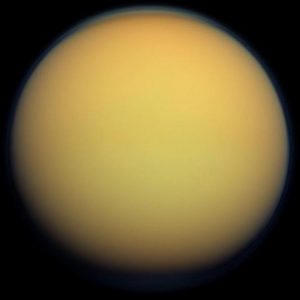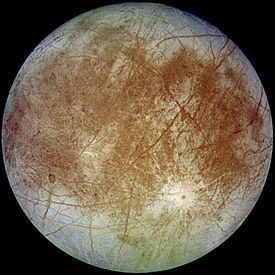We have discovered hundreds of planets which could potentially have extraterrestrial life, and are just waiting to be explored. Many scientists believe that there is alien life out there somewhere, and with the seemingly endless number of planets out there it seems almost impossible for there not to be life out there. Since the only life we know lives on earth, we know that the conditions we have on earth can help life flourish so the most likely places to find aliens will have conditions similar to our planet. Therefore the most likely planets to have extraterrestrial life are the ones most similar to earth.

Titan

Saturn’s moon Titan is one of the candidates of extraterrestrial life that’s closest to home. Titan is the only object other than earth to have clear evidence of stable bodies of liquid. Titan can be described as a moon like planet, and is 80% bigger than earth’s moon. It’s the second largest moon in the solar system. Titan is home to large hydrocarbon lakes. It’s believed that there could be droplets of ammonia mixtures rising inside Titan’s lakes. Titan is an exciting prospect for extraterrestrial life, and finding life in our own solar system other than our own would really be amazing.

Kepler 62e

Kepler 63e is a super earth exoplanet. An exoplanet is a planet outside of our solar system and a super earth is an exoplanet which has a higher mass than the earth’s but a substantially lower mass of the solar system’s gas giants Uranus and Neptune. This super earth was found within the habitable zone of Kepler 62. Kepler is 1.6 times more massive than earth. Like most of the best candidates this planet is far out of our reach, it’s 1,200 light years away. It’s believed to be a water world, which is either mostly or entirely covered in water.

Mars

Mars is the fourth planet from the sun and the second smallest planet in the solar system. The planet is named after the Roman god of war, and often referred to as the red planet. Mars is a terrestrial planet with a thin atmosphere. Although it’s unlikely that Mars has life now it’s possible that microbial life could have lived there in the past. Mars has plenty frozen water covering it’s poles, and the soil on Mars has 2 percent water by weight. One of the reasons mars is considered as a candidate for human life is it’s similarity to earth and the fact that water was discovered there.

Gliese 581g

Gliese 581 g is considered by the university of Peurto Rico to be the number one candidate for extraterrestrial life. It’s a rocky world only 20 light years away which is still a lot but much closer than other candidates. Although it’s a promising candidate the ESO/HARPS survey team was not able to confirm that it actually exists. The planets temperature is believed to be between -37 and -11 degrees Celsius. This planet could potentially have liquid water on it’s surface, and may be the planet with the closest mass to earth’s in the habitable zone. The discovery of gliese has led some scientists to believe that the proportion of stars with with habitable planets may be more than ten percent.

Kepler 22 b

Kepler 22 b is 600 light years from our sun and in the constellation of Cygnus. The planet is roughly 2.4 times the radius of the earth. It’s mass and surface composition remains unknown. Kepler could be a water world, and is in it’s solar system’s habitable zone. Kepler 22b is closer to it’s sun than we are, but it’s sun also has less light output which means it could have a habitable temperature not that different to our. The planets temperature may be 22% if it’s atmosphere produces a greenhouse effect similar to the magnitude we have on earth.

HD 40307g

Copyright Till Credner / (CC BY-SA 3.0)
HD 40307g is only 42 light years away in the constellation Pictor. It’s so close that we may even be able to observe it’s surface with a telescope in the future. The university of Hertfordshire in England said “The longer orbit of the new planet means that its climate and atmosphere may be just right to support life.” There is still a lot of debate over the size and habitable ability of the planet, it could be a large earth, or a small Neptune, the chances are about 50/50.

Europa

Europa is a moon orbiting Jupiter, and it has a huge ocean of liquid water under a sheet of ice. Europa is the sixth largest moon in the solar system, and the sixth-closest moon of Jupiter. It was discovered by the famous astronomer Galileo Galilei, in the year 1610. Europa is primarily made of silicate rock and has a water-ice crust, and most likely a an iron-nickel core. Extraterrestrial Life could exist on Europa in an environment similar to Earth’s deep-ocean Hydrothermal vents. Since life has been found in these environments in the deep ocean on earth, scientists surmise that they could also exist on Mars.

Venus

Venus is the second planet from the sun, orbiting it every 224.7 days. It has the longest rotations period of any planet in the solar system. It’s toxic atmosphere traps hear in a runaway version of the greenhouse effect that warms up the earth. As a result, temperatures on Venus reach 870 degrees Celsius. Because of it’s extreme temperature most people assume that it’s impossible for any life to survive on the planet but the high Venusian atmosphere has a survivable temperature, and atmospheric sulfur dioxide and carbon monoxide could potentially be sustenance for floating microbes.

Enceladus

Enceladus is the sixth largest moon of Saturn. Enceladus is mostly covered by ice, which reflects almost all the sunlight that touches it. It’s believed that hydrothermal activity may be at work in Enceladus’s subsurface ocean. If the conditions are what scientists believe them to be Enceladus could easily support life. NASA has spotted 101 geysers of water vapour and ice erupting from fractures near Enceladus’s south pole. Advanced machines, could actually fly throughout these geysers, and study the ocean there without any drilling, or even landing, which would save time and make it a lot more efficient.

Kepler 186f

Kepler 186 f is one of the best possibilities for extraterrestrial life. It is a rocky, habitable planet, and is only 10% bigger than Earth. This planet could even be colonised in a reasonable time. The problem is that this planet is hundreds of light years away, 490 light years to be exact. This is an impossible distance for us to reach right now, and would require an enourmous amount of money time. Kepler is in the habitable zone of it’s solar system’s atmosphere and is a good candidate for extraterrestrial life. The days on this planet are probably much longer then on earth, and a single day could last weeks or even months.

